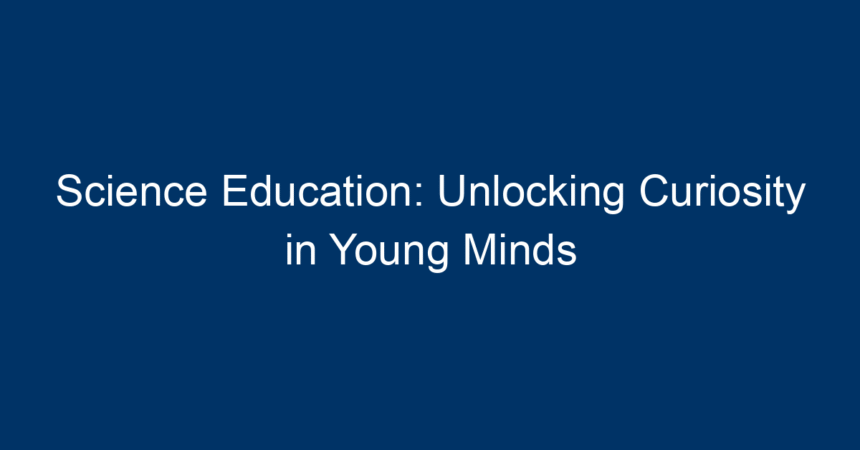In a world driven by rapid technological advancements and scientific discoveries, the importance of science education cannot be overstated. It serves as the foundation for critical thinking, problem-solving, and innovation. This article delves into how effective science education can unlock curiosity in young minds, fostering a generation of inquisitive thinkers poised to tackle complex challenges of the future.
The Importance of Science Education
Building a Strong Foundation
From an early age, children are naturally curious about the world around them. They ask questions like, “Why is the sky blue?” or “How do plants grow?” Establishing a solid foundation in science education helps cultivate this curiosity into a structured form of knowledge. This foundational understanding is vital as students progress through their academic careers and encounter increasingly complex scientific concepts.
Fostering Critical Thinking Skills
One of the core objectives of science education is to nurture critical thinking skills. Science encourages students to ask questions, gather evidence, and draw conclusions based on that evidence. This analytical approach extends beyond the classroom, equipping young minds with the tools they need to navigate daily life and make informed decisions. In an age dominated by misinformation, critical thinking is more essential than ever.
Encouraging Problem-Solving Abilities
Science education emphasizes the scientific method—a structured approach to problem-solving that involves observation, hypothesis formulation, experimentation, and analysis. By engaging in hands-on experiments and scientific inquiries, students learn to tackle complex issues methodically. This skill is not only applicable in academic settings but also in real-life situations, allowing students to approach problems with confidence and creativity.
Engaging Young Minds Through Experiential Learning
Hands-On Experiments
One of the most effective ways to engage students in science is through hands-on experiments. This experiential learning approach allows students to observe scientific principles in action, making the concepts more tangible and relatable. For example, conducting a simple experiment to grow plants can teach students about photosynthesis, ecosystems, and the importance of biodiversity.
Incorporating Technology
In today’s digital age, incorporating technology into science education is crucial. Virtual labs, interactive simulations, and science-related apps can transform traditional lessons into interactive experiences. These tools not only enhance understanding but also cater to different learning styles, ensuring that every child’s curiosity is ignited. By using platforms like simulation software or educational videos, educators can help students visualize complex processes that would otherwise be difficult to grasp.
Field Trips and Real-World Applications
Field trips to science museums, botanical gardens, or laboratories give students a firsthand look at scientific principles in action. These experiences can significantly enhance a child’s understanding and appreciation of science, making it more relevant to their lives. Such outings inspire curiosity and can even influence future career choices.
Creating an Inclusive Science Education Environment
Encouraging Diverse Perspectives
An effective science education curriculum values and encourages diverse perspectives. This inclusivity not only enriches the learning environment but also promotes collaboration among students. By engaging with peers from diverse backgrounds, students can explore scientific topics from different cultural and social contexts, broadening their understanding and appreciation of the subject.
Providing Support and Resources
To foster curiosity, educators need to provide the necessary support and resources. This includes access to materials for experiments, digital tools for research, and a safe space for asking questions and expressing ideas. Resources should be relevant to students’ interests and needs, ensuring that every child feels empowered in their scientific journey.
Promoting Collaboration and Teamwork
Science is inherently collaborative. Group experiments and projects encourage teamwork, allowing students to learn from each other while developing communication and interpersonal skills. By working together, students can share ideas and approaches, further fueling their curiosity and enhancing their learning experience.
The Role of Educators in Inspiring Curiosity
Passionate Teaching
Teachers play a pivotal role in igniting curiosity in young minds. A passionate educator who demonstrates enthusiasm for the subject can inspire students to explore scientific topics further. Engaging storytelling, real-life examples, and a genuine love for science can make lessons memorable and impactful.
Continuous Professional Development
To effectively teach science, educators must stay informed about the latest developments in the field. Continuous professional development allows teachers to refresh their knowledge, learn new teaching techniques, and stay updated on recent advancements in science. This commitment ensures that they provide their students with a rich and relevant learning experience.
Building a Safe Learning Environment
Creating a safe and supportive classroom atmosphere encourages students to ask questions without fear of ridicule. When students feel secure, they are more likely to express their thoughts, engage in discussions, and fuel their curiosity. A supportive environment also allows for mistakes to be viewed as learning opportunities, reinforcing the idea that inquiry and exploration are fundamental to the scientific process.
The Future of Science Education
Emphasizing STEM Education
The growing emphasis on STEM (science, technology, engineering, and mathematics) education reflects the increasing demand for skilled individuals in these fields. Integrating these subjects not only cultivates a deeper understanding of science but also prepares students for future careers in thriving industries. Programs that emphasize project-based learning and real-world applications can help students make connections between their studies and the world around them.
Encouraging Lifelong Learning
Encouraging a love for science extends beyond the classroom. By promoting lifelong learning, educators can inspire students to seek out knowledge throughout their lives. This mindset fosters a culture of curiosity that encourages individuals to stay informed and engaged with scientific advancements, making them responsible citizens in a rapidly changing world.
Conclusion: Actionable Insights for Parents and Educators
As we navigate an increasingly complex world, it is vital to prioritize science education and cultivate curiosity in young minds. Here are some actionable insights:
-
Encourage Exploration: Allow children to ask questions and explore their interests in science. Provide them with resources such as books, videos, and interactive websites.
-
Incorporate Hands-On Learning: Engage children in hands-on experiments at home or in the classroom. Encourage them to observe and discuss their findings.
-
Utilize Technology: Leverage digital tools and resources that make learning science interactive and fun. There are numerous apps and online platforms that can enhance the learning experience.
-
Promote a Growth Mindset: Help children view mistakes as opportunities for learning. Encourage them to keep trying and exploring even when they encounter challenges.
- Stay Informed: Parents and teachers should keep abreast of current scientific advancements and trends in science education to provide children with relevant and inspire learning experiences.
By working together, parents and educators can play a crucial role in unlocking curiosity in young minds through effective science education, paving the way for a generation of inquisitive thinkers ready to tackle the challenges of tomorrow. Ultimately, fostering a love for science is not just about lessons learned in school; it’s about nurturing a passion that will last a lifetime.




